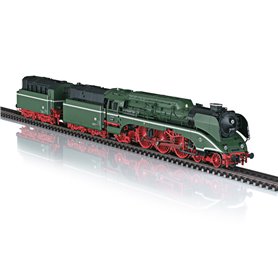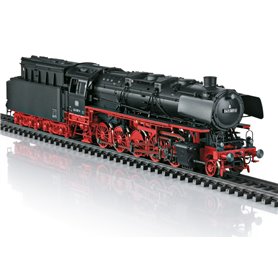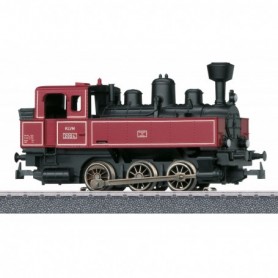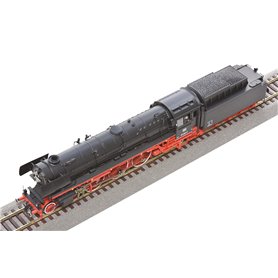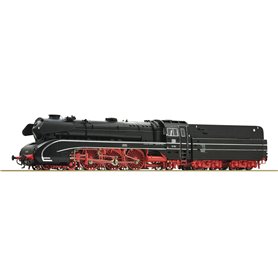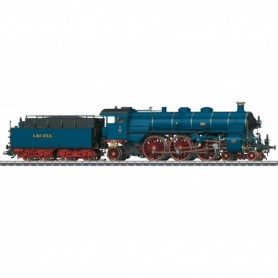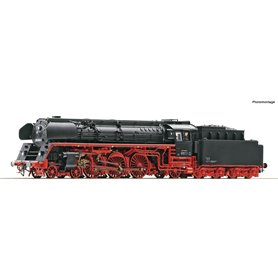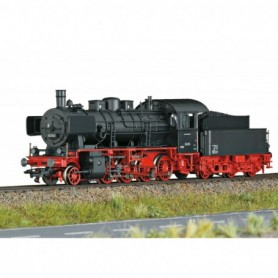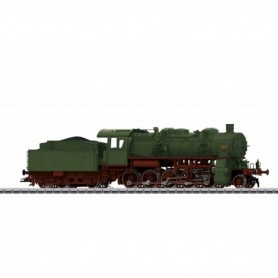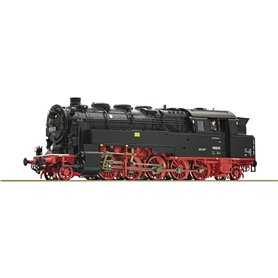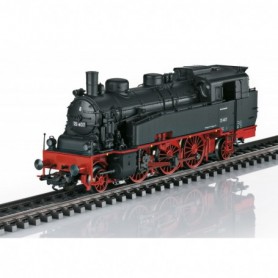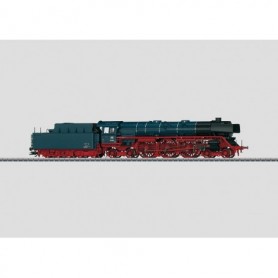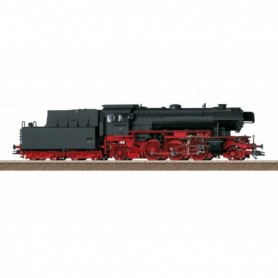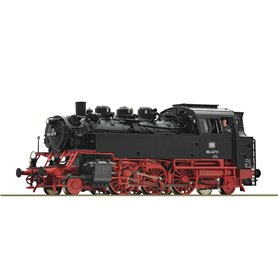Class 86 Steam Locomotive
This article can only be ordered with payment method invoice, we will inform you when the article is on stock (only applies to swedish customers).
-
 Secure payment in our shop!
Secure payment in our shop!
Class 86 Steam Locomotive
Model: The locomotive has an mfx+ digital decoder and extensive light and sound functions. It also has controlled, high-efficiency propulsion with a flywheel in the boiler. 4 axles powered. Traction tires. The locomotive is constructed mostly of metal. The 72270 smoke unit can be installed in the locomotive. Triple headlights change over with the direction of travel. They and the smoke unit contact will work in conventional operation and can be controlled digitally. Dual red marker lights can be controlled separately in digital operation. Cab lighting can also be controlled digitally. Maintenance-free, warm white and red LEDs are used for the lighting. There are numerous separately applied metal grab irons and lines. The minimum radius for operation is 360 mm / 14-3/16". Piston rod protective sleeves, brake hoses, and imitation prototype couplers are included separately. Length over the buffers 16.0 cm / 6-5/16".
Prototype: German State Railroad (DR/GDR) class 86 steam tank locomotive. Black basic paint scheme and red running gear. Version with 4 boiler appliances. Welded water tanks with long cutouts over the cylinders and rounded front edges. Triple headlights. Bell and turbo dynamo on the left, smoke box door with central locking and with a number board mounted below the middle of the smoke box door. Without inductive magnet. Coal bunker with an applied board. Pilot truck with spoked wheels. Trailing truck with solid wheels. Road number 86 1360-6. Stationed at RBD Cottbus, Zittau maintenance facility. The locomotive looks as did around 1973.
It was the period of the Golden Twenties when the German State Railroad newly founded in 1920 started its great leap forward in motive power technology. Countless locomotive types were taken over from the inheritance of the dissolved provincial state railways, and the upkeep of these locomotives was complex and uneconomical. The situation on branch lines was especially critical, where around 50 different classes chugged across the countryside. In addition, there were main line locomotives also earning their daily bread there.A hastily assembled committee for the standardization of locomotives was tasked with developing standard designs containing as many swappable parts as possible, a quantum leap in the very detailed motive power purchasing at that time.A general-purpose, very powerful, and fast tank locomotive was to introduce a new era on branch lines in addition to the classes 64 and 24. The selection fell to a 70 metric ton heavy design with four driving axles and a single-axle pilot truck and trailing truck. The class 86 was planned for this approximately 1,000 horsepower locomotive type.In 1928, the first of 16 pre-production locomotives was delivered to the German State Railroad. This began a truly successful story. These units turned in marvelous results â and not only on branch lines. With a maximum speed of 70 or 80 km/h / 44 or 50 mph and a high level of pulling power, they could also be used in passenger and local freight service on main lines. By 1943 774 units of the class 86 had been delivered to the German State Railroad. All the reputable locomotive builders such as BMAG, Borsig, Krupp, Henschel & Sohn, the Esslingen Machinery Company, Orenstein & Koppel, and Schichau (Elbing) participated in the building of the locomotives. The class 86 thereby belonged to the most built standard design locomotive, and no other standard design tank locomotive came even close to its quantities.Over the course of a long production period there were numerous design improvements with several of them altering the appearance of this successful locomotive. Starting with road number 86 378 in 1941 was the striking introduction of water tanks with an extended cutout in the front part. This was connected with better access to the control rod lever, to the Kuhnsch Loop, and to the swing arm.After the end of World War II there were 365 units of the class 86 on the network of the later German Federal Railroad. Except for one locomotive, all went over into operation on the DB. In 1957, another 14 units were added from the roster of the Saar railways. On the DB a second heyday of this popular and dependable "86" began. It now had to be a real jack-of-all-trades for everything: On main lines it was seen pulling long passenger trains and sometimes even limited stop fast passenger trains, and stations such as Frankfurt, Nürnberg, or Kassel were entered on a daily basis. Freight trains were in the operating plans of this general-purpose workhorse as well as switching service in freight yards. The class 86 was the dominant class on branch lines chiefly in Bavarian and Franconian areas. These locomotives were seen there for a long time pulling primeval local railroad cars steaming through attractive landscapes. They proved themselves the best once again in typical branch line local freight service.The retirement statistics show the importance of the class 86 in the Economic Miracle period: Although 595 units of the class V 100 had already been delivered by the end of 1964, the roster of the class 86 was still a significant 352 units at that time. Starting in 1965, its star began to sink rapidly. Only 38 units were given a new road number after the computer-generated numbering system was introduced in 1968. The last three class 86 units were put into storage by the DB in 1974. Ten class 86 units can still be admired in Western Germany, road numbers 86 333 and 744 on the Pressnitztal Railroad are even still operational and under steam they bring back memories of one of the most successful locomotive types on German rails.
This model can be found in a DC version in the Trix H0 assortment under item number 25087.
Completely new tooling.Intricate construction mostly of metal. Prototype selection is the longer variant of the class 86.Welded water tanks with rounded front edge. Long cutout on the water tanks. Pilot truck with spoked wheels.Trailing truck with solid wheelsCab lighting can be controlled separately in digital operation.Red marker lights can be controlled separately in digital operation.72270 smoke unit can be installed.World of Operation mfx+ digital decoder with a variety of light and sound functions.Buffer height conforms to the NEM.
The Bread-and-Butter Locomotive in Saxony
It was the period of the Golden Twenties when the German State Railroad newly founded in 1920 started its great leap forward in motive power technology. The new class 86 was especially successful, a 70 metric ton and 1,000 horsepower design with eight driving wheels and a pilot truck and a trailing truck. With a maximum speed of 70 or 80 km/h / 44 or 50 mph and a high level of pulling power, they could also be used in passenger and local freight service on main lines. By 1943, 774 units of the class 86 had been delivered to the German State Railroad. After the end of World War II there were over 164 usable class 86 locomotives on the German State Railroad of the GDR and most of them called Saxony home. They were able to prove their capabilities impressively there on the partially difficult routes in the Mittelgebirge Region. Even limited stop fast passenger trains and express trains were hauled with these nimble and powerful tank locomotives. This was also the case at the East Saxon maintenance facility in Zittau, where for example the limited stop fast passenger train E 681 from Berlin to Zittau was in the regular schedule of the class 86. Starting in 1968, 16 of the class 86 replaced the old Baden tank locomotives at the Zittau maintenance facility. One of the star locomotives in Zittau was road number 86 1360-6, which sparkled in the truest sense of the word due to its perfect condition. Especially interesting for a model railroader is the fact that the Zittau class 86 units were seen pulling old provincial railroad cars as well as what was then very modern "Reko" or "Converted" cars. The era of the class 86 in Zittau ran out in 1976. Its successor was represented by modern class V 100 diesel locomotives and class 52/52.80 wartime locomotives.
DR Cl. 86.0-8 Steam Tank Loc.
- Scale
- 1:87
- Country
- DR
- Epoch
- IV
- Current
- AC
- Option
- Digital Sound





